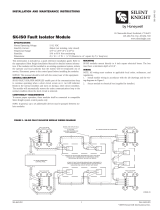
D550-06-00 1 I56-1367-004R
B501BHT
Temporal Tone Sounder Base
INSTALLATION AND MAINTENANCE INSTRUCTIONS
3825 Ohio Avenue, St. Charles, Illinois 60174
1-800-SENSOR2, FAX: 630-377-6495
www.systemsensor.com
Before Installing
Please read the System Smoke Detector Application Guide,
which provides detailed information on sensor spacing. place-
ment, zoning, wiring, and special applications. Copies of this
manual are available from System Sensor. NFPA 72 and NEMA
guidelines should be observed.
NOTICE: This manual should be left with the owner/user of
this equipment.
IMPORTANT: The detector used with this base must be tested
and maintained regularly following NFPA 72 requirements.
The detector should be cleaned at least once a year.
General Description
The B501BHT sounder base is used with System Sensor 200
and 500 Series sensor heads. Refer to the appropriate manual
for more information on sensors.
The B501BHT incorporates the distinctive three-pulse tempo-
ral pattern fire alarm evacuation signal now required by NFPA
72 for commercial and residential applications.
The sounder base is intended for use with intelligent systems.
Refer to the panel manual for the maximum allowable num-
ber of units per loop. The sounder base requires an external
24VDC supply with reverse polarity capability or a relay mod-
ule configured to reverse the power as in Figure 5. The con-
nections for the external supply (terminals 1 and 2) and the
communication loop (terminals 3 and 4) are isolated to pre-
vent electrical interaction between them.
When the sensor’s visible LEDs are latched on for approxi-
mately 10 seconds, the associated horn sounds. A loop of
horns can be made to sound by reversing the polarity of the
external supply when configured as in Figure 4 and 5. When
configured as in Figure 5, a loop of horns can also be made to
sound by turning on the Intelligent Relay Module.
Specifications
Base Diameter: 6.0 inches (15.2 cm)
Base Height (less sensor): 2.3 inches (5.9 cm)
Weight: 0.4 lb. (181 gm)
Operating Temperature Range: 32° to 120°F (0° to 49°C)
Operating Humidity Range: 10% to 93% Relative Humidity
Electrical Ratings
External Supply Voltage: 17 to 32 VDC
Standby Current: 1.0 mA maximum
Alarm Current: 15 mA maximum
Maximum Ripple Voltage: 10% of supply voltage
Start-up Capacitance: 200 µF
Communication/Initiating Loop Supply
Current Draw from Remote Output
of Sensor to turn on Horn: 700 µA maximum
Sound Output: Greater than 90 dBA measured in anechoic room at 10 feet, 24 volts. 85 dBA minimum
measured in UL reverberant room.
NOTE: When not used as a supplementary evacuation system
the external 24 VDC supply shall be treated as a component of
the main power supply system and shall fall under the require-
ments of the main power supply system per NFPA 72.
B501BHT Terminals
No. Function
1 External Supply Positive (+)
2 External Supply Negative (–)
3 Negative (–) Comm. Line In and Out
4 Positive (+) Comm. Line In and Out
5 Sounder Base Interconnect
Terminals 3 and 4 are used for the communication circuit.
Mounting
Mount the B501BHT directly to an electrical box, using the
mounting kit, supplied (see Figure 2).
The sounder base is 1.1-inches deep. Electrical boxes must
be 4-inches square by at least 1
1
⁄2 inches deep - 2
1
⁄8 inches is
recommended.
NOTE: A maximum space of
1
⁄8 inch from the outside edge of
the electrical box to the inside edge of the drywall or ceiling
tile is allowable.
Wiring Guidelines
All wiring must be installed in compliance with the National
Electrical Code and the local codes having jurisdiction and
must not be of such length or wire size which would cause
the base to operate outside of its published specifications. The
conductors used to connect smoke sensors to control panels
and accessory devices should be color coded to reduce the
likelihood of wiring errors. Improper connections can prevent
a system from responding properly in the event of a fire.
I56-1367-004R






